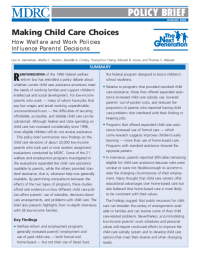Making Child Care Choices
How Welfare and Work Policies Influence Parents' Decisions
Reauthorization of the 1996 federal welfare reform law has rekindled a policy debate about whether current child care assistance provisions meet the needs of working families and support children’s intellectual and social development. For low-income parents who work — many of whom have jobs that pay low wages and entail working unpredictable, unconventional hours — the difficulties of securing affordable, accessible, and reliable child care can be substantial. Although federal and state spending on child care has increased considerably since 1996, most eligible children still do not receive assistance.
This policy brief summarizes new findings on the child care decisions of about 20,000 low-income parents who took part in nine random assignment evaluations conducted by MDRC. Some of the 21 welfare and employment programs investigated in the evaluations expanded the child care assistance available to parents, while the others provided standard assistance, that is, whatever help was generally available. By permitting comparisons between the effects of the two types of programs, these studies afford rare evidence on how different child care policies affect parents’ use of subsidies, decisions about care arrangements, and problems with child care. The brief also presents highlights from in-depth interviews with 38 low-income families.
Key Findings
- Welfare reform and employment programs generally increased parents’ employment and use of paid child care — both formal and home-based — but not their use of Head Start, the federal program designed to boost children’s school readiness.
- Relative to programs that provided standard child care assistance, those that offered expanded assistance increased child care subsidy use, lowered parents’ out-of-pocket costs, and reduced the proportion of parents who reported having child care problems that interfered with their finding or keeping jobs.
- Programs that offered expanded child care assistance increased use of formal care — which some research suggests improves children’s early learning — more than use of home-based care. Programs with standard assistance showed the opposite pattern.
- In interviews, parents reported difficulties remaining eligible for child care assistance because rules were unclear or were not flexible enough to accommodate the changing circumstances of their employment. Many thought that child care centers offer educational advantages over home-based care but also believed that home-based care is more likely to be consistent with their values.
The findings suggest that public resources for child care can broaden the variety of arrangements available to families and can resolve some of their child care-related problems. Nevertheless, accommodating low-income parents’ work schedules and personal values will require continued efforts to improve the child care subsidy system and to develop child care options that meet their diverse and often changing needs.






